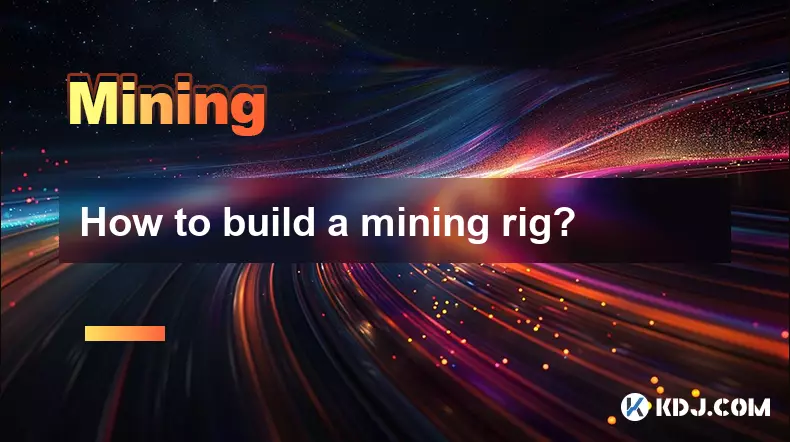-
 bitcoin
bitcoin $118548.520763 USD
3.67% -
 ethereum
ethereum $4352.564943 USD
4.79% -
 xrp
xrp $2.964058 USD
4.22% -
 tether
tether $1.000565 USD
0.05% -
 bnb
bnb $1028.372955 USD
1.46% -
 solana
solana $221.373507 USD
6.00% -
 usd-coin
usd-coin $0.999933 USD
0.02% -
 dogecoin
dogecoin $0.248633 USD
6.85% -
 tron
tron $0.341444 USD
2.38% -
 cardano
cardano $0.852946 USD
5.82% -
 hyperliquid
hyperliquid $47.869306 USD
6.15% -
 chainlink
chainlink $22.561476 USD
6.01% -
 ethena-usde
ethena-usde $1.001258 USD
0.05% -
 avalanche
avalanche $30.660000 USD
2.06% -
 stellar
stellar $0.400917 USD
9.76%
How to build a mining rig?
Choose powerful GPUs like the RTX 3090, pair with a mining-optimized motherboard, ensure sufficient PSU wattage, and use efficient cooling for optimal rig performance.
Sep 18, 2025 at 01:19 am

Choosing the Right Hardware Components
1. The foundation of any mining rig begins with selecting compatible and efficient hardware components. A powerful GPU is essential, with models like the NVIDIA RTX 3090 or AMD RX 6800 XT frequently preferred due to their high hash rates and energy efficiency in algorithms such as Ethash.
2. The motherboard must support multiple GPUs; options like the ASRock H110 Pro BTC+ are designed specifically for mining rigs and allow up to seven graphics cards to be connected simultaneously.
3. A reliable power supply unit (PSU) with sufficient wattage is crucial. Mining rigs often require PSUs rated between 1000W to 2000W depending on the number of GPUs, and using modular units helps manage cable clutter and improves airflow.
4. Though a CPU is necessary, it doesn’t need to be high-end. An entry-level processor like the Intel Celeron G3900 is adequate since most computational work is handled by the GPUs.
5. Use at least 4GB of RAM and a basic SSD (120GB or larger) to install the operating system and mining software. Stability and read/write speed matter more than capacity.
Assembling the Mining Rig
1. Begin by mounting the motherboard on a non-conductive surface, such as a wooden table or a dedicated mining frame. Ensure no metal parts directly touch the back of the board to prevent short circuits.
2. Install the CPU, RAM, and SSD onto the motherboard following standard procedures. Connect the PSU and ensure all power connectors are secure.
3. Attach each GPU using PCIe riser cables. These extenders allow vertical placement of graphics cards and improve ventilation. Make sure each riser is properly seated and powered via SATA or Molex connections from the PSU.
4. Double-check all power connections, especially the 8-pin or 6-pin power inputs on each GPU. Loose connections can lead to instability or hardware damage.
5. Organize cables using zip ties to maintain airflow and reduce fire hazards. Overheating is a major risk in densely packed rigs, so proper spacing and ventilation are critical.
Configuring Software and Connecting to a Pool
1. Install a lightweight operating system optimized for mining, such as HiveOS or SimpleMiner. These systems offer remote management, automatic driver installation, and real-time performance monitoring.
2. Once the OS is running, install the appropriate GPU drivers provided by NVIDIA or AMD. Some mining OS distributions include automated tools to simplify this process.
3. Choose mining software based on the cryptocurrency being mined. For Ethereum, popular choices include PhoenixMiner and T-Rex Miner. Configuration files typically require entering wallet addresses and pool server URLs.
4. Join a mining pool such as Ethermine or F2Pool to increase chances of earning consistent rewards. Solo mining is rarely profitable for individual operators due to difficulty levels.
Always verify that your wallet address and pool settings are correct before starting—sending hashes to the wrong destination results in permanent loss of earnings.Frequently Asked Questions
What is the ideal temperature range for a mining rig?Mining GPUs should operate between 60°C and 75°C under load. Temperatures exceeding 80°C may trigger throttling or reduce component lifespan. Adequate case fans and ambient cooling help maintain safe thermal levels.
How much electricity does a typical mining rig consume?A six-GPU rig using RTX 3070s might draw around 1200 watts continuously. Actual consumption varies based on GPU model, overclocking settings, and PSU efficiency. Monitoring tools within mining OS platforms provide real-time power usage data.
Can I use old or used GPUs for mining?Yes, many miners use refurbished or second-hand GPUs to reduce initial costs. However, thoroughly test each card for stability and check for prior mining use, as prolonged operation can degrade performance and reliability.
Is BIOS flashing necessary for mining GPUs?Flashing the GPU BIOS can unlock higher memory clocks beneficial for mining performance, especially on certain AMD cards. However, it carries risks including bricking the card if done incorrectly. Only experienced users should attempt this modification.
Disclaimer:info@kdj.com
The information provided is not trading advice. kdj.com does not assume any responsibility for any investments made based on the information provided in this article. Cryptocurrencies are highly volatile and it is highly recommended that you invest with caution after thorough research!
If you believe that the content used on this website infringes your copyright, please contact us immediately (info@kdj.com) and we will delete it promptly.
- BlockDAG, DOGE, HYPE Sponsorship: Crypto Trends Shaping 2025
- 2025-10-01 00:25:13
- Deutsche Börse and Circle: A StableCoin Adoption Powerhouse in Europe
- 2025-10-01 00:25:13
- BlockDAG's Presale Buzz: Is It the Crypto to Watch in October 2025?
- 2025-10-01 00:30:13
- Bitcoin, Crypto, and IQ: When Genius Meets Digital Gold?
- 2025-10-01 00:30:13
- Stablecoins, American Innovation, and Wallet Tokens: The Next Frontier
- 2025-10-01 00:35:12
- NBU, Coins, and Crypto in Ukraine: A New Yorker's Take
- 2025-10-01 00:45:14
Related knowledge

The difference between staking and mining
Sep 24,2025 at 05:18am
Understanding Staking in the Cryptocurrency Ecosystem1. Staking involves holding funds in a cryptocurrency wallet to support the operations of a block...

How to participate in testnet mining?
Sep 22,2025 at 09:18am
Understanding Testnet Mining in the Crypto Ecosystem1. Testnet mining is a method used by blockchain developers to simulate real-world conditions on a...

How to dispose of abandoned mining machines?
Sep 19,2025 at 08:19pm
Assessing the Condition of Abandoned Mining Rigs1. Begin by inspecting each mining machine for visible damage, corrosion, or missing components. Machi...

How to identify high-quality mining pools?
Sep 21,2025 at 03:19pm
Reputation and Track Record1. A mining pool’s reputation is built over time through consistent performance and transparency. Pools that have operated ...

Advantages of decentralized mining pools
Sep 20,2025 at 04:36pm
Enhanced Security and Resistance to Censorship1. Decentralized mining pools operate on blockchain-based smart contracts, eliminating the need for a ce...

What is mining machine overclocking?
Sep 21,2025 at 07:19pm
Understanding Mining Machine Overclocking1. Mining machine overclocking refers to the process of increasing the operating frequency of a cryptocurrenc...

The difference between staking and mining
Sep 24,2025 at 05:18am
Understanding Staking in the Cryptocurrency Ecosystem1. Staking involves holding funds in a cryptocurrency wallet to support the operations of a block...

How to participate in testnet mining?
Sep 22,2025 at 09:18am
Understanding Testnet Mining in the Crypto Ecosystem1. Testnet mining is a method used by blockchain developers to simulate real-world conditions on a...

How to dispose of abandoned mining machines?
Sep 19,2025 at 08:19pm
Assessing the Condition of Abandoned Mining Rigs1. Begin by inspecting each mining machine for visible damage, corrosion, or missing components. Machi...

How to identify high-quality mining pools?
Sep 21,2025 at 03:19pm
Reputation and Track Record1. A mining pool’s reputation is built over time through consistent performance and transparency. Pools that have operated ...

Advantages of decentralized mining pools
Sep 20,2025 at 04:36pm
Enhanced Security and Resistance to Censorship1. Decentralized mining pools operate on blockchain-based smart contracts, eliminating the need for a ce...

What is mining machine overclocking?
Sep 21,2025 at 07:19pm
Understanding Mining Machine Overclocking1. Mining machine overclocking refers to the process of increasing the operating frequency of a cryptocurrenc...
See all articles










































































